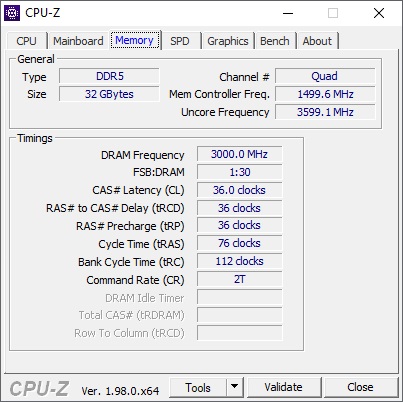Intel Alder Lake DDR5 Memory Scaling Analysis With G.Skill Trident Z5
by Gavin Bonshor on December 23, 2021 9:00 AM ESTG.Skill Trident Z5 Memory (F5-6000U3636E16G)
2x16GB of DDR5-6000 CL36
For the purposes of this article and to investigate scaling performance on Alder Lake, G.Skill supplied us with a kit of its latest Trident Z5 DDR5-6000 CL36 memory. The G.Skill Trident Z series has been its flagship model for many years, focusing on performance but blending in a premium and clean-cut aesthetic. G.Skill offers two types of its Trident Z5 memory, some without RGB LEDs such as the kit we are taking a look at today (Z5), and the Trident Z5 RGB, which includes an RGB LED light bar along the top of each memory stick.
Focusing on the non-RGB variants, the G.Skill Trident Z D5 is available in various 32 GB (2x16) configurations starting at DDR5-5600 CL36 and ranging up to DDR5-6000 CL36. G.Skill unveiled a kit of Trident Z D5 RGB DDR5-7000 CL40 kit, which is extremely fast, and when it is released, it will ultimately be one of the most, if not the most, expensive DDR5 memory kit on the market.
Looking at the design, the G.Skill Trident Z5 DDR5 memory uses a 42 mm tall (at the highest point) heatsink, with G.Skill offering a two-tone contrasting matte black kit, as well as a black and metallic silver kit. The kit supplied to us by G.Skill uses two-tone matte black heatsinks. The heatsinks are constructed from aluminum, and G.Skill states that it uses a newer and more 'streamlined' design. There are quite pointy, which given previous G.Skill memory kits might have the tendency to feel too sharp when installing them.
Looking at what CPU-Z is reporting, we can see that the X.M.P 3.0 profile matches up with the advertised specifications, with this particular kit using DDR5-6000 with latency timings of 36-36-36-76. The operating voltage for the kit is 1.3 V, which is a 0.2 V bump from the JEDEC SPD rating of this kit, which is DDR5-4800 at 1.1 V.
Checking the more intricate details of the G.Skill Trident Z5 DDR5-6000 memory, CPU-Z reports that the kit is using Samsung IC's, with a 1Rx8 array of 16 Gb ICs employed on each module. While CPU-Z doesn't actually report this, we reached out to G.Skill who informed us that this kit uses a single rank design.













82 Comments
View All Comments
Slash3 - Thursday, December 23, 2021 - link
Process Lasso, not Project Lasso. ;)(This has happened in previous articles, too)
futrtrubl - Thursday, December 23, 2021 - link
Interesting that 5800 seems consistently better in these tests. I wonder if there is a timing/ratio related reason for that.evilspoons - Thursday, December 23, 2021 - link
Consistently worse, no? The times are longer and the frame rates are lower.meacupla - Thursday, December 23, 2021 - link
I would like to see IGPU performance with the various speeds.Now, I know the IGPU on desktop alder lake is poor, but AMD 6000 APUs are right around the corner, and I would like to see how well IGPU scales on DDR5 in general.
gagegfg - Thursday, December 23, 2021 - link
There is almost no difference. UHD 770 has very poor performance and does not scale as well with higher bandwidth as it does on AMD's IGPU.meacupla - Thursday, December 23, 2021 - link
well that's a shameWrs - Thursday, December 23, 2021 - link
Amd's iGPU hardly scales on DDR4 - can't really tell it apart from CPU scaling or even run to run variance.praeses - Thursday, December 23, 2021 - link
They typically see a 10% performance increase going from 3200-4000 with similar timings, the delta grows if you're comparing loose 3200 and tight 4000 timings.Samus - Thursday, December 23, 2021 - link
I suspect the memory bus is the limiting factor with AMD iGPU's as all of their recent memory architectures (going back to at least Polaris) were 128-bit+ DDR5 or HBM.The rare, NERFed examples paint a clearer picture: the only Polaris desktop GPU on 64-bit was the R7 435 (I think) and it had DDR3 at 2GHz. It was slower than most APU's at the time and remains one of those recent desktop cards that shouldn't have ever existed for desktop PC's. There just aren't many 64-bit cards, especially on DDR3, that return reasonable gains over integrated graphics; both are going to be so underperforming neither will play games reasonably well.
TheinsanegamerN - Tuesday, December 28, 2021 - link
I think tha tmostly comes down to AMD's memory controller then, considering those APUs are running on dual channel 128 bit memory busses.DDR4 just isnt that good for GPUs, easily demonstrated with the GT 1030 which, depsite its lack of power, was severely hamstrung on DDR4 VS 5.